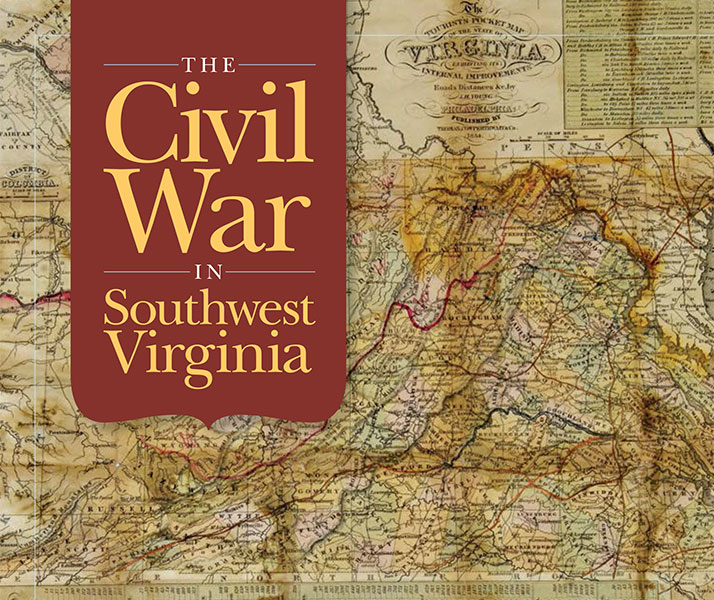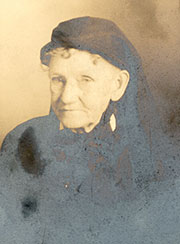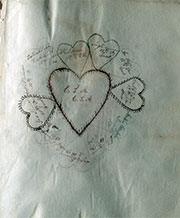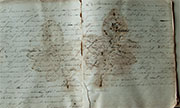
The Civil War in Southwest Virginia
By Darlene Richardson ’94, M.A.L.S. ’96, C.A.S. ’99
Ellen Adair was a sweet, somewhat silly 17-year-old and well into her second year at Hollins Institute when one day in January 1863, with the Civil War showing no sign of ending anytime soon, her father unexpectedly showed up to take her home. Ellen’s idyllic days as a Hollins student were ending, and fate held cards it had yet to show. Diary entries from the period show the impact of war on a formerly quiet part of the state.

Tourist pocket map of the state of Virginia by James Hamilton Young. Published by S. Augustus Mitchell (Philadelphia), 1854.
Many Southwest Virginians are familiar with famous battles of the American Civil War that happened in such places as Antietam, Gettysburg, Atlanta, Vicksburg, New Orleans, Richmond, or Manassas. Yet few are aware that this region, too, was a beehive of war activity. Hundreds of soldiers—many of them strangers from distant places, representing both sides of the war—came to Southwest Virginia with guns, wagons, and horses for various reasons during the war’s duration. They were noisy, unpredictable, and disruptive, and their war activities agitated the once-calm rural air and changed the lives of Southwest Virginians—including Ellen Adair’s—permanently.
Ellen Adair, born in 1845, was the oldest daughter of Irish immigrant James Adair. She lived with her parents, eight siblings, and 15 slaves on a 1,500-acre plantation in Giles County known as Bell Point. Although the precise location of Bell Point is unknown today, it was near a major turnpike—now Route 460—and the New River. Travelers often sought overnight accommodations at private homes along the turnpike, as hotels and boarding houses were typically located only in large towns and cities. According to Ellen Adair’s diary, soldiers and other boarders stopped by Bell Point nearly every night for meals or a bed.

A photo of Ellen Adair Gooch around 1930, provided by her great-granddaughter, Patricia Wright.
Ellen attended Hollins Institute from November 1861 to January 1863, but her diary continued until 1865, providing a glimpse of her life in two settings: as a student at Hollins and as a young woman at home in search of love and meaning.
On the day before her 17th birthday, on March 30, 1862, Ellen wrote her first diary entry: “I am at Hollins Institute going to school. I came here in November 1861. Poage Hansbarger from Monroe came with me, and at Christmas Cousin Ellen came here, too. We then roomed in the middle passage but on the 6th of March we moved here on Pleasants Street No. 10. Today I took my History examination. I answered most all the questions but do not expect to get a certificate though I tried very hard.”
As the Civil War entered its second year in April 1862, Ellen’s first year at Hollins was winding down. She attended a concert and began preparing, like many of her classmates, to return home. On the eve of her departure, she reflected on her first year: “This time last year, there was at least fifty persons here [instructors, staff, students’ family members] and now where are they? Some perhaps in the grave and others in the army.”
Once she arrived back at Bell Point, she wrote that “[we] got to Salem in plenty time for the [railroad] cars. Col. Clarkson came all the way with us. We had a fine time on the cars…& saw a ‘heap’ of soldiers. …as we passed through Pearisburg all was confusion. A great many refugees and sick soldiers in town.”
“What a day this has been. Our pickets came to the nearest point, about 400 of them, & fired upon the Yankees. The bullets fell round the house like hail.”
Just as Ellen was readjusting to life at home, the Union Army arrived in the vicinity. Over the next two weeks, she described a battle that took place virtually at her front door. It was reported in The New York Times, Baltimore Sun, and other newspapers as the Battle of Giles Court House between Gen. Henry Heth [Confederate States of America, or C.S.A.] and Lt. Col. Rutherford B. Hayes [23rd Ohio Volunteer Infantry].
On May 16, 1862, she wrote: “What a day this has been. Our pickets came to the nearest point, about 400 of them, & fired upon the Yankees. The bullets fell round the house like hail. Several struck the house. The Yankees did not return fire but ran off as fast as possible but soon came back & stayed all night.” The next day she wrote, “I shall not forget this day soon. The Yankees left this morning early on ‘double quick’ for camp.”

Ellen embellished her diary with treasured mementos. She sketched hearts to encircle names or initials of acquaintances and friends who were dear to her.
In August 1862, Ellen returned to Hollins “to be a schoolgirl & though I am studying ‘right well’ yet it cannot turn my thoughts from those I love in the ‘Tented Field.’” The war became a major distraction for Ellen, who was then in her late teens, and many soldiers corresponded with her. One diary entry reads: “Once more the pleasant news greeted my ears this morning…from that ‘friend’ on the ‘battlefield.’ …reading his letter did I think of the many pleasant, yes the many happy hours spent with that one at my own dear house.”
Still, Ellen treasured her days at Hollins, which served as a sanctuary from the bustle of soldiers and boarders at home. One entry dated Saturday, November 8, 1862, describes a memorable afternoon spent with classmates and hints at a prologue to today’s Tinker Day tradition:
“Shall the girls who visited ‘Tinker’ ever forget the beauty with which the mountains and valleys were clothed and the sublime magnificence that was there exposed to our view? I think not.”
Shall I ever forget this day? No, I will ever look back to it as a day of pleasure for the girls of ‘Hollins.’ Shall the girls who visited ‘Tinker’ ever forget the beauty with which the mountains and valleys were clothed and the sublime magnificence that was there exposed to our view? I think not. I am sure that I could not forget it even though I should wish. I often thought whilst climbing the mountain of our poor dear soldiers & how often they have to climb the almost perpendicular mountains & often suffer from cold & hunger. But the day I hope is fast approaching when all those dear ones can return to their homes in peace.
After Ellen’s father removed her from school on January 29, 1863, her life changed in many ways. Sickness and death were looming, pervasive visitors. She often complained of dyspepsia or feeling ill and made note of others’ conditions or demise. In 1862 her Cousin Mollie died from a sudden stroke when “only five months ago she was a bride.” Ellen’s mother, Jane Swart Adair, became suddenly ill the morning of March 5, 1863. Doctors Carter and Easly were called, but she continued “laying quite senseless,” not having spoken for days. She died on March 10, 1863, and Ellen was inconsolable. “My heart is sad & lonely. Very lonely since Mother died. Oh, how sad it is to be without a Mother. .…all the world seems blank to me, and I feel that I would almost long to lie beside her in the grave, but it is all for my own good.” Several pages from this period were torn from her diary, so we can only surmise that rereading those passages was too painful.
On May 14, 1863, she wrote of the death of General “Stonewall” Jackson: “Oh! How saddened my spirits are as I am seated to record the death of the heroic Jackson! The whole nation will weep as the telegraph carries the sad intelligence far and wide.” In 1864, death even claimed one of her closest friends, Poage Hansbarger, “a dear schoolmate at Hollins. Far away from home…she was called to leave the world…[to] stand before the ‘bar of God.’…if I could have been with her when she died!”
After her mother died, it fell upon Ellen, as the oldest female in the house, to assume the role of hostess for the family’s increasing number of guests and visitors: “several companies of the 60th [Va.] have gone up. …Mr. Alexander of the 36th was here Monday and Tuesday taking up deserters. …Mr. Tompkins of the 8 Va. is here. …Capt. Walder & Sgt. Miller from the Battery took breakfast here this morning. …Otey’s Battery left the Narrows today. …the house is full of company.” The family even hosted C.S.A. Senator Newman around the time that Virginia was divided into two states.
The war brought a veritable smorgasbord of young men into Ellen’s life, a departure from her antebellum days. She carried on flirtations or fell in love with many young soldiers, recording, for example, on May 1, 1863, that an unnamed soldier, “the Adjutant, kissed me. Oh! How I felt. I do not know. The first kiss, Oh! So sweet!” Afterward she was “determined to resist every emotion of love that arises in my heart and check every rising sigh.”
I have gotten two letters from my 17th Capt. His last was a dear love letter & more a confession of love asking me to say ‘your fate shall be mine.’ I’ll pretend [to be] half in love with him.”
As fate would have it, the war delivered Ellen’s future husband to her doorstep. His arrival had been foretold five months earlier, in May 1863: “I forgot to record one fortune Sis & I tried tonight but although it is not as I wanted, yet I’ll record the letters: I see perhaps _____ will bring to my presence the ‘dear unknown’ whose initials were turned up. They were ‘W.T.P.S.’ Oh I wonder if I’ll ever meet anyone bearing those initials.” Although most of the initials were out of order, Captain Thaddeus “Thad” P. Waldo and his unit, Company C of the 17th Virginia Cavalry (C.S.A.), rode past Bell Point for the first time on October 26, 1863. By December, the young captain was smitten with Ellen and ardently pursuing her: “I have gotten acquainted with a very nice Capt. of 17th Cav. He has been here several times. I captivated him the last time he was here.” And this: “I have gotten two letters from my 17th Capt. His last was a dear love letter & more a confession of love asking me to say ‘your fate shall be mine.’ I’ll pretend [to be] half in love with him.”
One of the mysteries of Ellen Adair’s diary is how, by the spring of 1864, Capt. Waldo had fully captured her heart. A nearly two-month gap in her diary stirs the imagination. On March 10, 1864, she wrote, “I have often imagined I loved and even believed it, but never until I pledged my heart and hand to Capt. Waldo did I know truly the meaning of love. The word Love will scarcely express my devotion for him.” On March 30 she wrote, “Today is my birthday of 19. A year ago I was carrying on a flirtation with Adj. H[arden]. Now I am loving another better than my own self and perhaps before another birthday I may be wed and in another ‘clime.’”

Pressed between its pages was a bouquet of flowers “from Tinker” picked by her friend Poage (Hansbarger) during their first month at Hollins.
Darlene Richardson attended Hollins as a Horizon student and majored in American studies. She returned for her M.A.L.S. and C.A.S. degrees with concentrations in history. She has been a historian at the U.S. Department of Veterans Affairs in Washington, D.C., for more than 10 years and provides internships to Hollins and other students on a regular basis.
